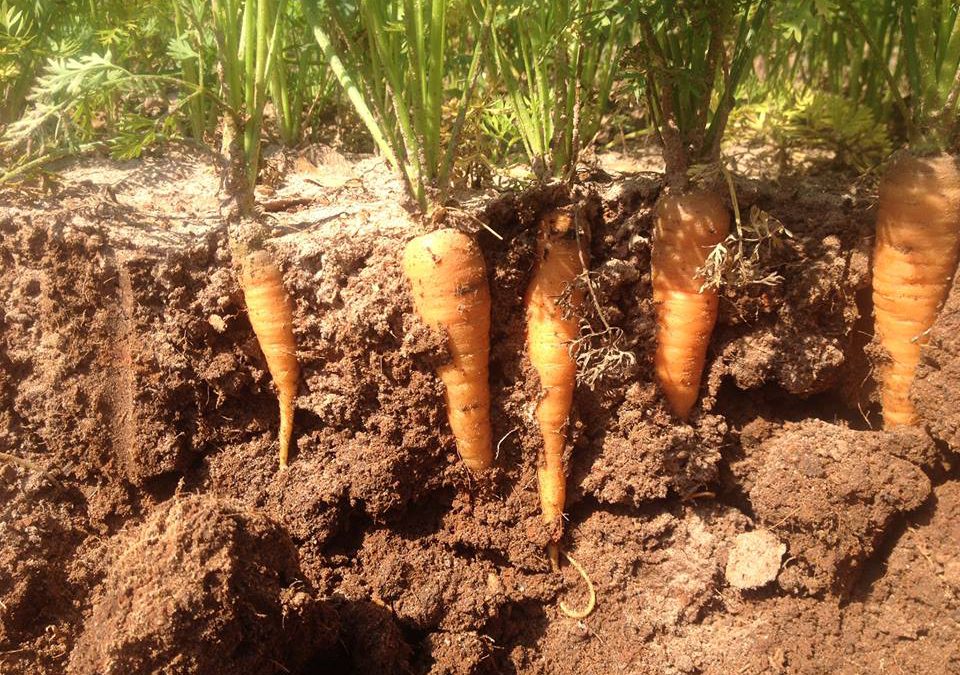
by Molly Jameson | Aug 18, 2021
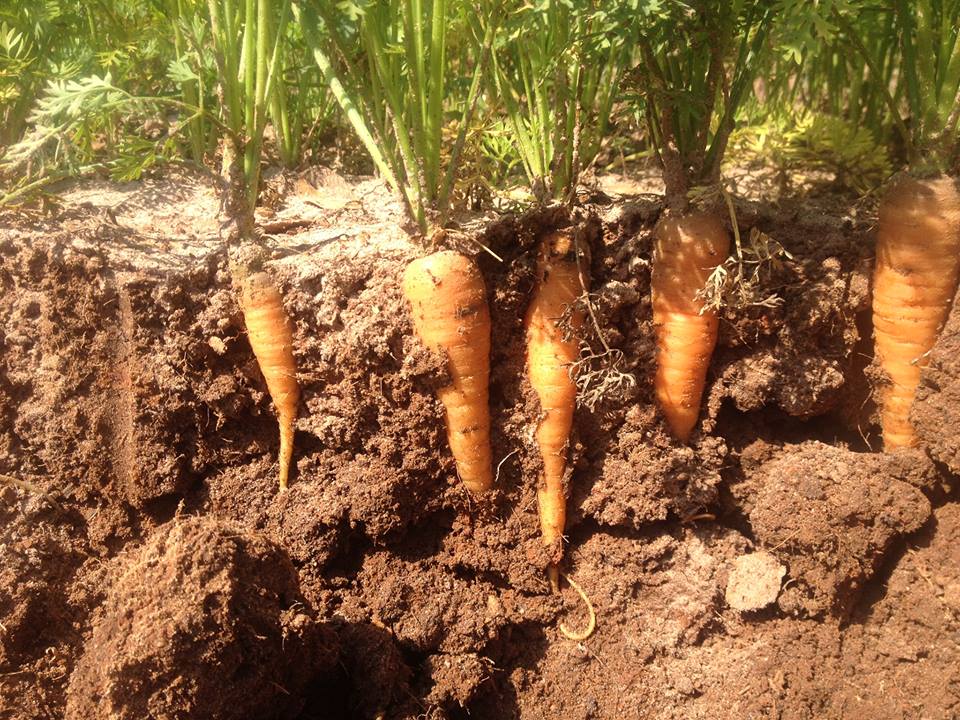
Carrots need enough space so as not to compete for light, nutrients, or moisture. Photo by Full Earth Farm.
Of all the garden veggies, carrots are very close to the top of my list of favorites to grow. They can be directly seeded into the garden, need no pruning or staking, can hold up magnificently in the cold, have few pest problems, are easy to harvest, can be eaten raw or cooked, and they are, of course, delicious.
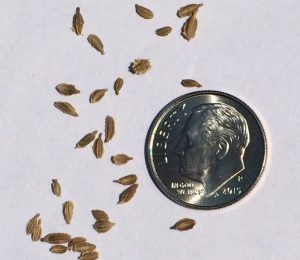
Hand-seeding carrots can be a challenge, as the seeds are very small. Photo by Molly Jameson.
Carrots are in the Apiaceae, or umbel family, along with cilantro, celery, fennel, parsley, and dill. Flowers in the umbel family grow as short flower stalks which spread from one point, like that of an upside-down umbrella, hence their name. If the carrot root is not harvested, the plant will produce beautiful umbrella-like inflorescences the following year, as carrots are biennial.
When planting carrots, there are some important aspects to keep in mind. Here in Florida, carrots thrive in our cool season. They prefer soil temperatures to be less than 80°F for good germination and air temperatures below 75°F for best growth. Therefore, waiting until mid-September through October to seed will yield better germination and growth.
One of the biggest mistakes one can make in the garden is neglecting to thin seedlings. And carrots – whose seeds are a mere millimeter in length – are one of the prime culprits.
An individual carrot needs one to three inches of soil space, depending on the variety, to grow to full maturity and not compete for light, nutrients, or moisture. This, however, does not mean that you must only plant one carrot seed per one to three inches. In fact, carrots should be seeded one-half inch apart, especially when day temperatures are above 75°F, as you may have spotty germination. But the key is proper thinning. Carrots take between seven to 21 days to germinate, so be sure to give them time, and be sure to keep the area consistently moist, but not water-logged.
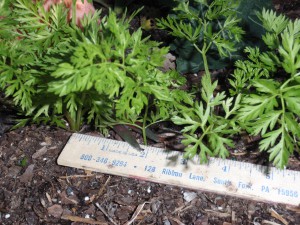
Depending on the variety, carrots need one to three inches per plant. Photo by Beth Bolles.
Once germinated, it is crucial to make your first thinning. Find the seedlings that are less than an inch apart and simply cut their stems at the soil line using either a sharp fingernail or garden sheers. Depending on the variety of carrot and seeding density, you may need to make another thinning to ensure the carrots have enough room to prosper.
I know it can be emotionally challenging to remove growing seedlings from your garden – but remember – it’s for the greater carrot good!
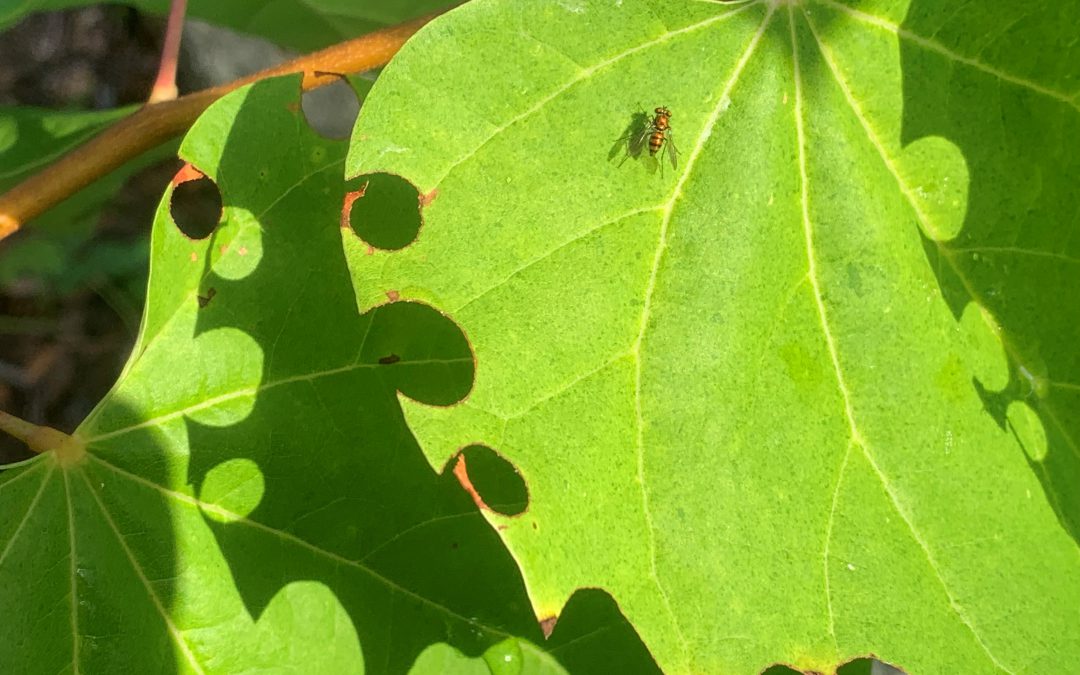
by Beth Bolles | Aug 18, 2021
In a garden with a variety of flowers, pollinators will be abundant. Sometimes we don’t always recognize the specific pollinator when we see it, but there are some native pollinators that leave other signs of their activity. One of our medium-sized native bees will leave a distinctive calling card of recent activity in our landscape.
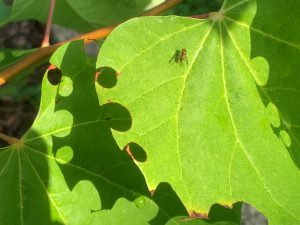
Leafcutter bees have collected circular notches from the edges of a redbud tree. Photo by Beth Bolles, UF IFAS Extension Escambia County.
If you see some of the leaves of trees and shrubs with distinct circular notches on the edges of the leaves, you can be sure the Leafcutter bee is present. The females collect the leaf pieces to make a small, cigar-shaped nest that may be found in natural cavities, such as rooting wood, soil, or in plant stems. Each nest will have several sections in which the female places a ball of pollen and an egg. The emerging larvae then have a plentiful food source in order to develop into an adult bee.
When identifying a leafcutter bee in your landscape, look for a more robust bee with dark and light stripes on the abdomen. These bees also have a hairy underside to their abdomen where they carry the pollen. When loaded with pollen their underside will look yellow.
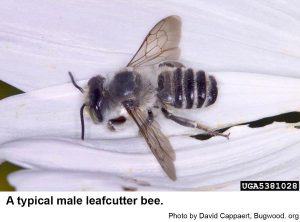 Leafcutter bees are solitary bees that are not considered aggressive. A sting would only be likely if the bee is handled. Your landscape will have many plants that a leafcutter may use for nesting material. The pollinating benefits of these bees far outweigh any cosmetic injury to the plant leaf margins.
Leafcutter bees are solitary bees that are not considered aggressive. A sting would only be likely if the bee is handled. Your landscape will have many plants that a leafcutter may use for nesting material. The pollinating benefits of these bees far outweigh any cosmetic injury to the plant leaf margins.
Visit Featured Creatures to see a photo of the leaf pieces made into a nest.
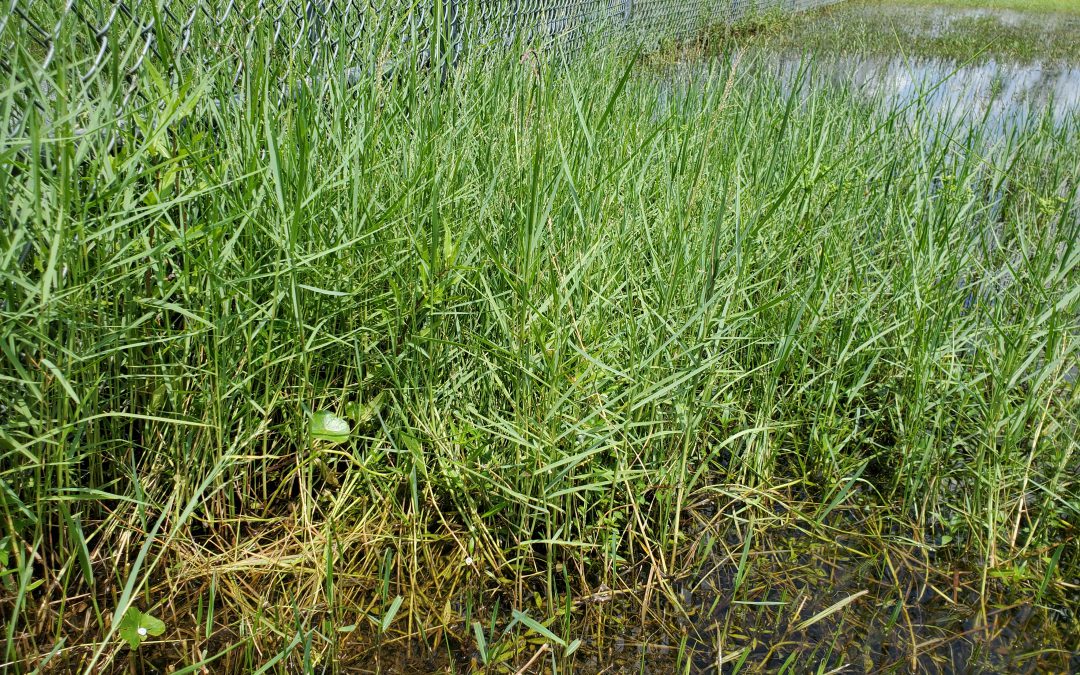
by Daniel J. Leonard | Aug 18, 2021
One of the most conspicuous outcomes from Hurricane Michael was the complete disruption of local lawns and landscapes. Giant holes where tree roots once existed, ruts and compacted ground from clean-up equipment, and formerly shaded acres flooded with fresh sunshine were three very common situations property owners suddenly found themselves faced with. An unforeseen consequence of all this newly bare ground ripe was the intrusion by a variety of very aggressive weeds. One invasive exotic weed that has made itself right at home in many county landscapes following Michael and that I’ve seen lots of lately is Torpedograss (Panicum repens).
Often brought into landscapes with “fill-dirt” and “topsoil” applications or spread through mowing, Torpedograss is an aggressive perennial grass in the same plant family as Bermudagrass and Cogongrass. Like many invasive exotic species, Torpedograss was introduced into the United States in the late 1800’s from its native Africa and Asia as a potential forage crop. Unlike its cousin Cogongrass, the Torpedograss is highly palatable to cattle and so gained a quick following among the ranching community. Unfortunately, over the next century, Torpedograss had left the pasture and turned into one of the biggest pest plants in Florida, ruining many a lawn, taking over 70% of the state’s public waterways, disrupting native marshlands, and costing Florida over $2 million a year to control!
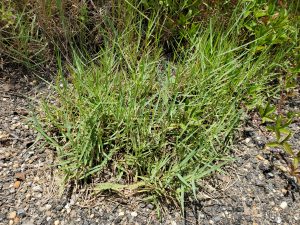
Torpedograss growing in a Calhoun County gravel driveway. Photo courtesy of Daniel Leonard.
Torpedograss spreads rapidly through underground, sharply pointed, white-colored, “torpedo-like” growing tips and can dominate wet or dry areas in short order. The species often hides in lawns when mixed in and mowed with other turfgrasses (especially Zoysiagrass, which it closely resembles), growing unnoticed until infestations are severe and control options are few. This makes scouting for the weed and accurate identification crucial! Torpedograss can be identified by its bluish-green leaf and stem color, hairy leaf edges, stiff overall appearance, distinctive panicle-type flowers, and can grow quickly to 3’ or so in height, spreading indefinitely. Though it initially can resemble other turf species, once you know what you’re looking for, Torpedograss stands out visually amongst its competitors.
After identifying Torpedograss, control methods can be chosen depending on the site it has infested. In lawns, options vary based on turf species. If infestation occurs in the common Centipedegrass and Bahiagrass lawns of the Panhandle, options are few. Products with the active ingredient Sethoxydim (Poast, Fertilome Over the Top, Southern Ag Grass Killer, etc.) can suppress Torpedograss growth in these situations but will not destroy it and are not permanent options. If the area infested is not large, killing the whole spot out with a non-selective herbicide like Glyphosate (Roundup and generics) and then resodding is probably a better option. In Bermudagrass or Zoysiagrass lawns, products with the active ingredient quinclorac (Drive and generics) are very effective at controlling Torpedograss without having to go the “nuclear” glyphosate route. Unfortunately, there are no effective controls for Torpedograss in St. Augustinegrass lawns.
In landscaped beds, Torpedograss is somewhat easier to control. Hand pulling in beds can be effective where new invasions occur but are impractical once the weeds gain a strong foothold. Once that occurs, chemical control is required. In bare or mulched areas away from plants, careful spot spraying in bare areas with a 2-3% glyphosate solution is extremely effective. Where the Torpedograss has grown into and through landscape plants, an “over-the-top” application of fluazifop (Fusilade) will take out the weed without harming most ornamental plant species! (Be sure to check the Fusilade label to make sure your ornamental plant species are safe to apply to!)
Torpedograss is one of the most serious, yet overlooked, invasive plants that occurs in Florida. However, through prevention and control techniques like cleaning mowers when mowing infested areas, accurate identification, and prompt, effective herbicide use, you can keep the weed from taking over your lawn and landscape! For assistance in identifying and controlling Torpedograss and other lawn weeds, contact your local UF/IFAS County Extension office! Happy gardening!
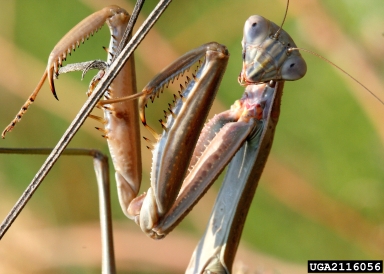
by Mary Salinas | Aug 18, 2021
For those of you who tuned into the July 29 edition of Gardening in the Panhandle LIVE, beneficial insects was the topic of the day. Here are links to the publications our panelists talked about.
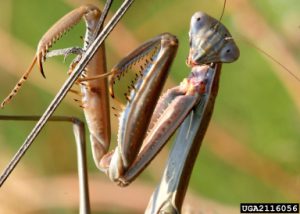
Mantid. Photo credit: David Cappaert, Bugwood.org.
How do I identify the kind of insect I have?
Recognizing beneficial bugs: Natural Enemies Gallery from UC Davis http://ipm.ucanr.edu/natural-enemies/
How to distinguish the predatory stink bug from the ones that harm our crops: https://entomology.ces.ncsu.edu/wp-content/uploads/2014/01/FL-pred.jpg
How to tell difference in stink bugs and leaf footed insects. Are both harmful? UF/IFAS Featured Creatures: leaffooted bug – Leptoglossus phyllopus (Linnaeus) (ufl.edu)
How can I tell bad beetles from good ones? Helpful, Harmful, Harmless Identification Guide is one resource available: http://ifasbooks.ifas.ufl.edu/p-153-helpful-harmful-harmless.aspx
How can we encourage beneficial insects?
How can we encourage the beneficial insect species?
- Plant more flowers attract pollinators that also feed on insects.
- Diversity of plants in the landscape.
- Use softer or more selective pesticides to minimize damage to beneficials.
Is it helpful to order beneficial insects such as lady bugs? Encouraging Beneficial Insects in Your Garden OSU: https://catalog.extension.oregonstate.edu/sites/catalog/files/project/pdf/pnw550.pdf
How effective is buying predatory insects to release in your greenhouse? Natural Enemies and Biological Control: https://edis.ifas.ufl.edu/publication/IN120
Can I buy beneficial insects to start breeding in my garden? Natural Enemy Releases for Biological Control of Crop Pests: https://www2.ipm.ucanr.edu/agriculture/natural-enemy-releases-for-biological-control-of-crop-pests/
What benefit would result by planting city right-of-ways with native wild flowers? https://edis.ifas.ufl.edu/publication/in1316; https://adamgdale.files.wordpress.com/2020/03/gcm_feb2020.pdf
Can an individual gardener sustain an ecosystem for beneficial insects? Penn State Article on beneficial insects that mentions some flowering plants that help support predators and parasitoids: https://extension.psu.edu/attracting-beneficial-insects
Specific Insects
How do I get rid of mole crickets? UF/IFAS Mole Crickets: https://edis.ifas.ufl.edu/entity/topic/mole_crickets
Are wasps really beneficial? Beneficial Insects: Predators!: https://sfyl.ifas.ufl.edu/sarasota/gardening-and-landscaping/horticulture-commercial/integrated-pest-management/beneficial-insects/
Is a dish soap solution effective against wasps? Soaps, Detergents, and Pest Management: https://gardeningsolutions.ifas.ufl.edu/care/pests-and-diseases/pests/management/soaps-detergents-and-pest-management.html
How to control leaf footed bugs? Handpick them, attract beneficials, create diverse plantings in landscape, accept some damage, and control them when in the juvenile stage.
Can you tell me about praying mantids? Praying Mantids: https://entomology.ca.uky.edu/files/efpdf2/ef418.pdf
Are there any beneficial insects that keep mosquito populations down? Dragonfly larvae in water, mosquitofish
What are the little insects that hop out of centipede grass? Are they beneficial?
Spittlebugs and your lawn: https://nwdistrict.ifas.ufl.edu/hort/2020/05/27/spittlebugs-and-your-lawn/
How to stop Eastern Black Swallowtail Butterflies laying eggs on parsley – the hatched caterpillars eat it all. Plant extra or put a screen over plant.
Extra fun video!
Take a look at this video of parasitic wasp attacking aphids: Parasitic Wasps | National Geographic – YouTube
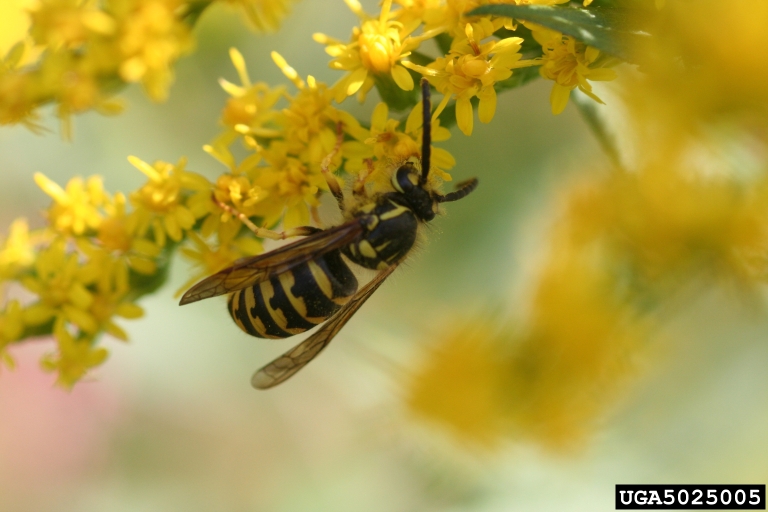
by Danielle S. Williams | Aug 11, 2021
Integrated Pest Management or ‘IPM’ is a sustainable approach to managing plant pests by using several different methods to cause the least harm to people, property, and the environment. IPM focuses on the management of problems rather than their eradication. Using IPM strategies in your garden is one way to ensure its productivity!
Avoiding Pest Problems
Prevention is key to IPM! It is important to select the right plant, for the right place at the right time. It’s also important to select pest-resistant plant varieties and maintain healthy plants through proper watering and fertilization.
- Plan before you plant. Be sure not to plant in a location not suited for a particular plant. Stressed plants are more susceptible to insects and disease.
- Start with healthy plants. Do not plant plants with insects or disease.
- Monitor the lawn and garden regularly. You’ll want to be able to detect a pest problem earlier rather than later.
- Water and fertilize properly. Too much of either can make plants vulnerable to insects and disease.
- Encourage beneficial insects in your garden. Learn to recognize the insects in your garden and let the good ones do the work for you!
Recognizing Pest Problems
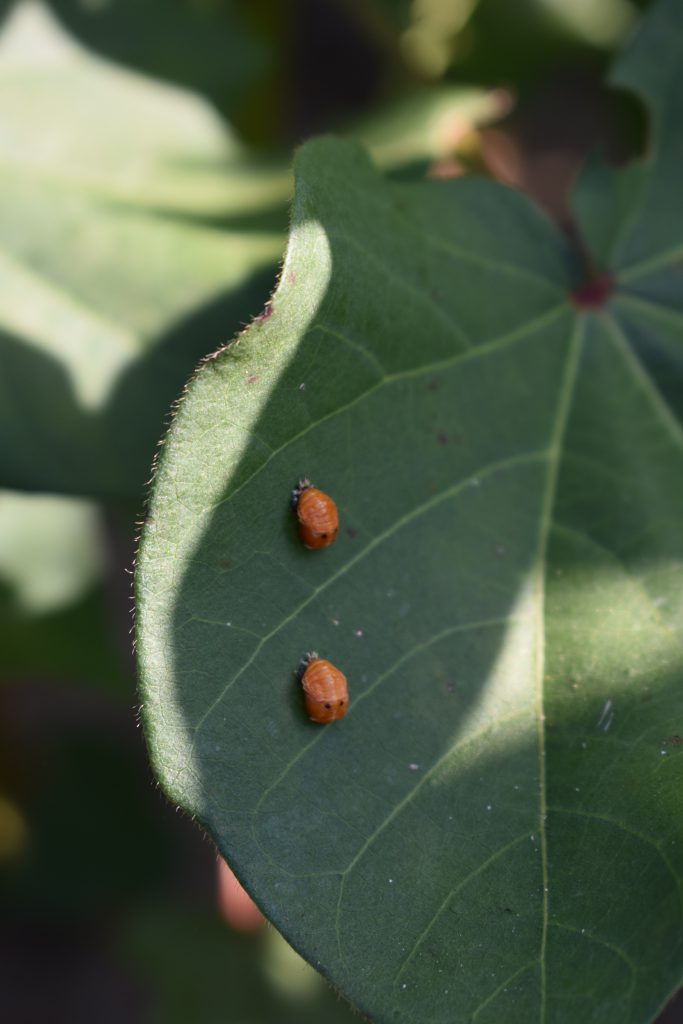
Depending upon the insect and the life cycle stage they are in, they may look different than we are used to! Here is a photo of the pupal stage of a lady beetle.
Scouting or monitoring the garden or plants in the yard frequently helps detect problems early. Some of the common insects you’ll find in your garden are: aphids, mealybugs, scales, whiteflies, thrips, mites, caterpillars, and stinkbugs. Often times you’ll find damage from the insect before you see the insect itself. Chewed or deformed leaves, sooty mold or a colony of ants scurrying up and down stems are all signs an insect may be present.
Treating Pest Problems
IPM is the best strategy for dealing with pests in the lawn and garden. IPM strategies:
- Remove affected plant leaves or parts. If an insect or disease is heavily concentrated in an area, you can reduce or eliminate the problem by simply removing it.
- Pick insects off by hand. Be sure to dispose of them so they don’t make it back into the garden.
- Look for beneficial insects. If you see a pest outbreak, try to determine if it is being managed by natural enemies. Many insects such as ladybugs and lacewings prey on pest insects and removing them will just help the pest insects. If you need help identifying insects, contact your local county Extension agent!
- Try the above strategies before pesticide use. If the problem persists and pesticides are needed, use products that have a reduced-risk to the environment such as insecticidal soaps, horticultural oils, botanicals, or microbials.
- Read and follow all pesticide label instructions. The label is the law!
For more information on integrated pest management, please visit:













